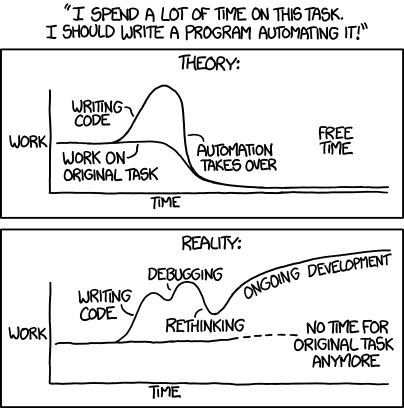VMware Virtual Network: Stuck Between the Past and the Future
If you want to implement overlay virtual networking with VMware products today, you have two options: use vCNS 5.5 or NSX for vSphere… and I would be hard pressed to choose one or the other.
Post #2000
When I started blogging in 2006, I had no idea that I’d still be doing it 8 years later… and I never dreamed of writing my 2000th post (this one, according to my blogging platform).

A virtual cake I got from my lovely daughter ;)
IPv6 reachability between ULA and GUA endpoints
From the IPv6 Trivia department: can a host with an ULA address reach a service with a global IPv6 address? Can a host with only a link-local address reach a service with a global IPv6 address? The answer to both questions might be Yes (but you better know what scopes and zones are if you want to figure it out).
Automation Explained
Just in case you've missed it: the ultimate explanation of DevOps, NetOps and other automation ideas.
Network Monitoring with OpenFlow
You know how hard it is to get the network traffic statistics: interface counters are too coarse, Netflow records are too granular, Sflow is sampling… life is hard for network monitoring Goldilocks.
In the Network Monitoring video (part of Real-Life OpenFlow Use Cases webinar) I explained an interesting alternative: you could get (hardware permitting) traffic counters with ever OpenFlow flow entry, resulting in any granularity you need.
PA, PI or ULA IPv6 Address Space? It depends
Having “do we need ULA” blogologs with Ed Horley is great … and the best part of them is that we’re both right (aka: It Depends). OK, let’s try to quantify that last part.
Published on , commented on July 9, 2022
Control and Data Plane Separation – Three Years Later
Almost three years ago the OpenFlow/SDN hype exploded and the Open Networking Foundation started promoting the concept of physically separate control and data planes. Let’s see how far its founding members got in the meantime:
vSphere Does Not Need LAG Bandaids – the Network Might
Chris Wahl claimed in one of his recent blog posts that vSphere doesn't need LAG band-aids. He's absolutely right – vSphere’s loop prevention logic alleviates the need for STP-blocked links, allowing you to use full server uplink bandwidth without the complexity of link aggregation. Now let’s consider the networking perspective.
IPv6 pings and path MTU discovery
More news from the IPv6 is not like IPv4 department: there's no DF bit in IPv6, so you have to use slightly different troubleshooting tricks to figure out the path MTU size (and they depend on the operating system). More in a detailed blog post by my good friend Matjaž Straus.
Controller Implementation Choices Affecting OpenFlow Scalability
The first part of the Real-life OpenFlow Use Cases webinar focused on controller design and implementation choices that can significantly impact the scalability of an OpenFlow solution:
- Proactive versus reactive flow setup;
- Hop-by-hop versus path-based forwarding;
- State explosion with OpenFlow 1.0;
You could tell we had great fun with these topics: we spent more than half an hour on five slides.
Published on , commented on July 9, 2022
What Exactly Is SDN (And Does It Make Sense)?
When Open Networking Foundation claimed ownership of Software-Defined Networking, they defined it as separation of control and data plane:
[SDN is] The physical separation of the network control plane from the forwarding plane, and where a control plane controls several devices.
Does this definition make sense or is it too limiting? Is there more to SDN? Would a broader scope make more sense?
Interfacing Overlay Virtual Networks with MPLS/VPN WAN
During my ExpertExpress engagements with engineers building multi-tenant cloud infrastructure I often get questions along the lines of “How do I integrate my public IaaS cloud with my MPLS/VPN WAN?” Here are a few ideas.
Source IPv6 Address Selection Saves the Day
My recommendation to use ULA addresses for internal communications within organizations that don’t have their own provider-independent address space resulted in the following comment:
[…] Having ULA for internal company communication and global IPv6 addresses for communication with the Internet will cause lots of issues with application guys since now application has to bind to specific IPv6 address for internal communications and another IPv6 address to go to the Internet.
Numerous aspects of IPv6 may still be broken, but fortunately this is not one of them.
How Did Software Defined Networking Start?
Software-Defined Networking is clearly a tautological term – after all, software defined networking device behavior ever since we stopped using Token Ring MAUs and unmanaged hubs. Open Networking Foundation claims it owns the definition of the term (which makes approximately as much sense as someone claiming they own the definition of red-colored clouds), but I was always wondering who coined the term in the first place.
VMware NSX Gateway Questions
Gordon sent me a whole list of NSX gateway questions:
- Do you need a virtual gateway for each VXLAN segment or can a gateway be the entry/exit point across multiple VXLAN segments?
- Can you setup multiple gateways and specify which VXLAN segments use each gateway?
- Can you cluster gateways together (Active/Active) or do you setup them up as Active/Standby?
The answers obviously depend on whether you’re deploying NSX for multiple hypervisors or NSX for vSphere. Let’s start with the former.

